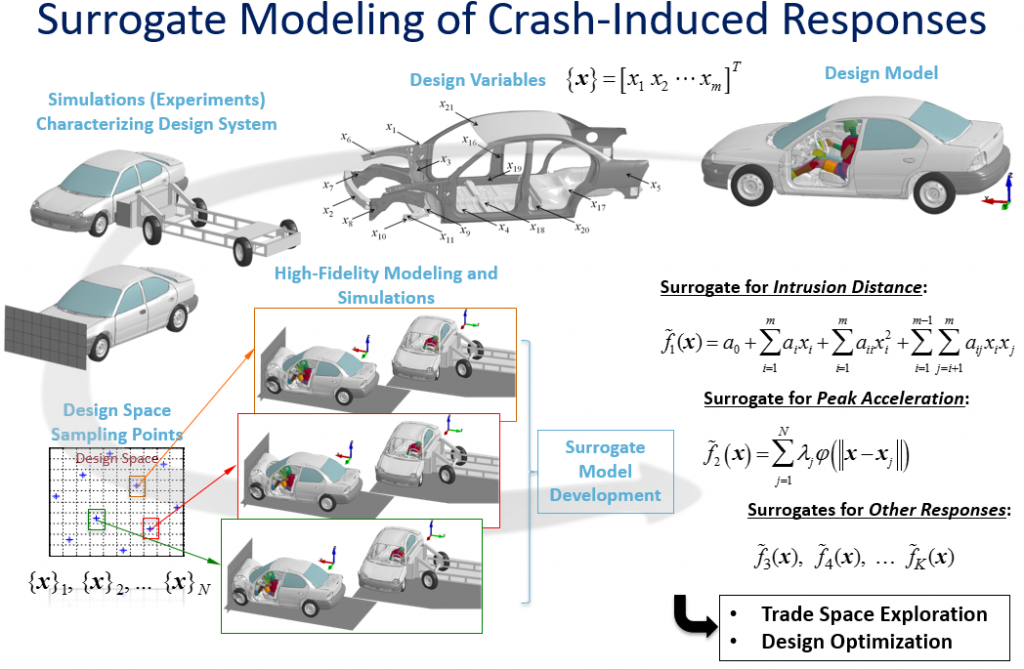Masoud Rais-Rohani: Reduced Order & Surrogate Modeling Research
The goal of this research is to facilitate simulation-based design optimization involving computationally expensive and often noisy responses using both parametric and non-parametric surrogate-modeling (metamodeling) techniques and to develop a new approach based on an optimized ensemble of surrogate models.
Highlights of research sponsored by DOE, NASA and ERDC:
- Surrogate-based optimization of automotive structures under multiple design criteria
- Ensemble of metamodels with weight factors optimized using alternative cross validation metrics
- Surrogate modeling in multi-objective optimization

A full-frontal or side impact simulation for estimation of a response function (e.g., peak acceleration, intrusion distance) could take several hours on a computer cluster. Through surrogate modeling, a smooth and computationally efficient representation of each response function can be generated. Such models can be extremely helpful in both trade space exploration and design optimization pursuits.
Publications: (*Student, **Postdoc)
- Parrish*, J., Rais-Rohani, M., and Janus, M., “Reduced Order Techniques for Sensitivity Analysis and Design Optimization of Aerospace Systems,” AIAA Journal, Vol. 53, No. 12, pp. 3567-3576, 2015.
- Parrish*, J., Rais-Rohani, M., and Janus, M., “Application of Reduced Order Techniques for Sensitivity Analysis to Multidisciplinary Aerospace Systems,” AIAA SciTech 2015: 56th AIAA/ASCE/AHS/ASC Structures, Structural Dynamics, and Materials Conference, Kissimmee, FL, Jan 5-9, 2015.
- Parrish*, J., Rais-Rohani, M., and Janus, M., “Reduced Order Techniques for Sensitivity Analysis and Design Optimization of Aerospace Systems,” AIAA SciTech 2014: 10th AIAA Multidisciplinary Design Optimization Specialist Conference, National Harbor, MD, Jan 13-17, 2014.
- Kiani*, M., Gandikota*, I., Parrish*, A., Motoyama, K., and Rais-Rohani, M., “Surrogate-Based Optimisation of Automotive Structures Under Multiple Crash and Vibration Design Criteria,” International Journal of Crashworthiness, Vol. 18, No. 5, pp. 473-482, 2013.
- Acar**, E. and Rais-Rohani, M., “Ensemble of Metamodels with Optimized Weight Factors,” Structural and Multidisciplinary Optimization, Vol. 37, No. 3, pp. 279-294, 2009.
- Acar**, E. and Rais-Rohani, M., “Ensemble of Metamodels with Optimized Weight Factors,” 4th AIAA Multidisciplinary Design Optimization Specialists Conference, Schaumburg, IL, Apr 7-10, 2008.
- Fang, H., Rais-Rohani, M., Liu*, Z., and Horstemeyer, M., “A Comparative Study of Metamodeling Methods for Multi-objective Crashworthiness Optimization,” Computers and Structures, Vol. 83, pp. 2121-2136, 2005.
- Rais-Rohani, M. and Singh*, M., “Comparison of Global and Local Response Surface Techniques in Reliability-Based Optimization of Composite Structures,” Structural and Multidisciplinary Optimization, Vol. 26, No. 5, pp. 333-345, 2004.
- Fang, H., Rais-Rohani, M., and Horstemeyer, M.F., “Multi-objective Crashworthiness Optimization with Radial Basis Functions,” 10th AIAA/ISSMO Multidisciplinary Analysis and Optimization Conference, Albany, NY, Aug 30-Sep 1, 2004.
- Rais-Rohani, M. and Singh*, M. N., “Efficient Response Surface Approach for Reliability Estimation of Composite Structures,” AIAA-2002-5604, 9th AIAA/ISSMO Symposium on Multidisciplinary Analysis and Optimization, Atlanta, GA, Sep 4-6, 2002.
- Su*, B., Rais-Rohani, M., and Singh, M. N., “Reliability-Based Optimization of Anisotropic Cylindrical Shells with Response Surface Approximations of Buckling Instability,” AIAA-2002-1386, 43rd AIAA/ASME/ASCE/AHS/ASC Structures, Structural Dynamics and Materials Conference, Denver, CO, Apr 22-25, 2002.
